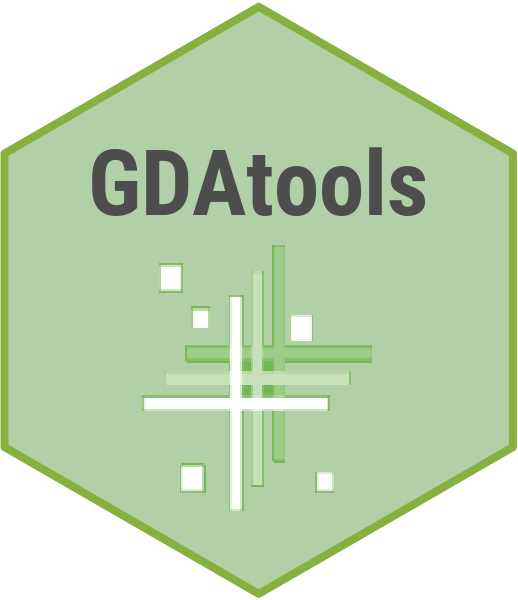Geometric Data Analysis.
GDAtools
Geometric Data Analysis
GDAtools provides functions for Geometric Data Analysis :
- Specific Multiple Correspondence Analysis
- Class Specific Analysis
- Nonsymmetric Correspondence Analysis
- two-table and k-table analyses : Multiple Factor Analysis, between- and within-class analysis, MCA and PCA with instrumental variables or orthogonal instrumental variables, discriminant analysis, coinertia analysis, etc.
- guides for interpretation (contributions, quality of representation, test-values, etc.)
- analysis of structuring factors (concentration ellipses, interactions, etc.)
- inductive analysis (typicality and homogeneity tests, confidence ellipses)
- bootstrap validation
- many graphical representations for MCA and variants (with and without
ggplot2) - plots for hierarchical clustering
Initially, I developed GDAtools because the FactoMineR package, which I was using at the time, did not offer some of the techniques I needed, in particular specific MCA. So I tried to program the main functions of GDAtools to be compatible with the MCA of FactoMineR and vice versa. Then I discovered the ade4 package, which offers an incredibly rich range of possibilities. However, it is oriented towards ecology, which does not exactly correspond to the needs of social scientists (of which I am one). Still, I was very much inspired by it for the GDAtools 2.0 version, in particular for the multi-table methods, with instrumental variables, etc. Lately, I have also tried to develop the package a bit beyond the GDA toolkit "à la Le Roux et Rouanet", which was the initial goal.
Documentation
Please visit https://nicolas-robette.frama.io/GDAtools/ for documentation
Installation
Execute the following code within R:
if (!require(devtools)){
install.packages('devtools')
library(devtools)
}
install_git("https://framagit.org/nicolas-robette/GDAtools")
Citation
To cite GDAtools in publications, use :
Robette N. (2025), GDAtools : Geometric Data Analysis in R, version 2.2, https://nicolas-robette.frama.io/GDAtools/
References
A selective list of the handbooks that helped me to develop the package, although there are many other very useful ones (first of all Benzécri's books)
Bry X., 1995, Analyses factorielles simples, Economica.
Bry X., 1996, Analyses factorielles multiples, Economica.
Escofier B. and Pagès J., 2008, Analyses factorielles simples et multiples, Dunod.
Fénelon J.-P., 1981, Qu'est-ce que l'Analyse des Données?, Lefonen. (The image in the package hex sticker is taken from this book's cover.)
Lebart L., Morineau A. and Warwick K., 1984, Multivariate Descriptive Statistical Analysis, John Wiley and sons, New-York.
Le Roux B. and Rouanet H., 2004, Geometric Data Analysis: From Correspondence Analysis to Stuctured Data Analysis, Kluwer Academic Publishers, Dordrecht.
Le Roux B. and Rouanet H., 2010, Multiple Correspondence Analysis, SAGE, Series: Quantitative Applications in the Social Sciences, Volume 163, CA:Thousand Oaks.
Saporta G., 2006, Probabilités, analyses des données et statistique, Editions Technip.
More specific references on some techniques present in the package
Abdi H., 2007, "Discriminant Correspondence Analysis", In: Neil Salkind (Ed.), Encyclopedia of Measurement and Statistics, Thousand Oaks (CA): Sage.
Bouchet-Valat M., 2015, "L'analyse statistique des tables de contingence carrées - L'homogamie socioprofessionnelle en France - I, L'analyse des correspondances", Bulletin de Méthodologie Sociologique, 125, 65–88. <doi>
Bry X., Robette N., Roueff O., 2016, "A dialogue of the deaf in the statistical theater? Adressing structural effects within a geometric data analysis framework", Quality & Quantity, 50(3), 1009–1020 <doi>
Cibois P., 2014, Les méthodes d’analyse d’enquêtes. Nouvelle édition en ligne. Lyon: ENS Éditions.
De Leeuw J et van der Heijden PGM, 1985, Quasi-Correspondence Analysis, University of Leiden.
Dolédec S. and Chessel D., 1994, "Co-inertia analysis: an alternative method for studying species-environment relationships", Freshwater Biology, 31, 277–294.
Escofier B., 1990, "Analyse des correspondances multiples conditionnelle", La revue de Modulad, 5, 13-28.
Escofier B. and Pages J., 1994, "Multiple Factor Analysis (AFMULT package)", Computational Statistics and Data Analysis, 18, 121-140.
Escoufier Y., 1973, "Le traitement des variables vectorielles", Biometrics, 29, 751–760.
Escoufier Y., 1987, "The duality diagram : a means of better practical applications". In Development in numerical ecology, Legendre, P. & Legendre, L. (Eds.) NATO advanced Institute, Serie G. Springer Verlag, Berlin, 139–156.
Kroonenberg P.M. and Lombardo R., 1999, "Nonsymmetric Correspondence Analysis: A Tool for Analysing Contingency Tables with a Dependence Structure", Multivariate Behavioral Research, 34 (3), 367-396.
Lebart L., 2006, "Validation Techniques in Multiple Correspondence Analysis". In M. Greenacre et J. Blasius (eds), Multiple Correspondence Analysis and related techniques, Chapman and Hall/CRC, p.179-196.
Lebart L., 2007, "Which bootstrap for principal axes methods?". In P. Brito et al. (eds), Selected Contributions in Data Analysis and Classification, Springer, p.581-588.
Saporta G., 1977, "Une méthode et un programme d'analyse discriminante sur variables qualitatives", Premières Journées Internationales, Analyses des données et informatiques, INRIA, Rocquencourt.
Tucker L.R., 1958, "An inter-battery method of factor analysis", Psychometrik, 23-2, 111-136.
Van der Heijden PGM, 1992, "Three Approaches to Study the Departure from Quasi-independence", Statistica Applicata, 4, 465-80.

